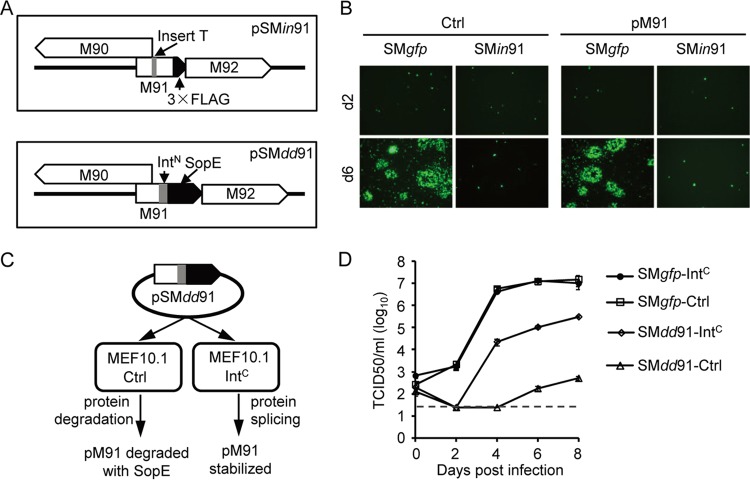FIG 4.
M91 is essential for MCMV replication in fibroblasts. (A) Representative diagram of the pM91-deficient recombinant BACs pSMin91 and pSMdd91. pSMin91 has a single nucleotide insertion (T before nt 210) (indicated by the gray box) within the M91 coding sequence, resulting in a frameshift mutation. pSMdd91 contains the SopE coding sequence (indicated by the black box) and part of the gp41-1 split intein (IntN; indicated by the gray box) at the 3′ end of the M91 coding sequence. (B) Control (Ctrl) or pM91-expressing (pM91) MEF10.1 cells were transfected with wild-type BAC pSMgfp or mutant BAC pSMin91, and GFP signals were observed using fluorescence microscopy. (C) Working model of the pM91-deficient virus using the intein-mediated modulation of the protein stability system. Without IntC, SopE induces rapid degradation of the entire fusion protein, effectively depleting pM91 during infection. However, after intein splicing, SopE is released from pM91 and pM91 expression is rescued, supporting viral growth. (D) Control (Ctrl) or HA-mCherry-IntC-FLAG (short for IntC)-expressing MEF10.1 cells were infected with SMgfp or SMdd91 at an MOI of 0.01. At the indicated time points, the supernatants of infected cells were harvested and analyzed by the 50% tissue culture infective dose (TCID50) assay using MEF10.1-IntC cells. The detection limit of the TCID50 assay is indicated by the dashed line.

